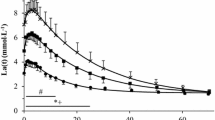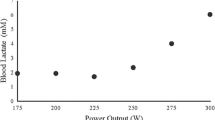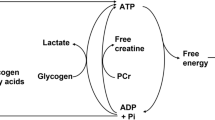Summary
Arterial blood lactate was measured at 10 s time intervals after a 3 min strenuous exercise for six athletes pedaling a bicycle ergometer in the sitting position. Recovery curves were fitted to the equation:
.
The evolution of arterial lactate concentrations during recovery can accurately be represented by this equation. The values of the coefficients A and γ found were used for a numerical application to an open two-compartment model: the “working muscle space” (1) and the “lactate space” (2). Intramuscular concentrations, the transfer coefficients from compartment 1 to compartment 2 and from compartment 2 to compartment 1 and the fractional turnover and basal turnover rate were calculated. Computed intramuscular lactate concentrations at the end of exercise compare favorably with those found earlier by muscular biopsic samplings. The turnover data are higher than those previously reported. This discrepancy may possibly be attributed to the method of mathematical analysis.
Similar content being viewed by others
Abbreviations
- A 1, A 2 :
-
Amplitudes of the two exponential terms fitted on the arterial lactate concentrations (Μmol·l−1)
- B 1, B 2 :
-
Amplitudes of the two exponential terms of the intramuscular lactate concentrations (mol·l−1)
- BM :
-
Body mass
- BTR :
-
Basal turnover rate of the lactate pool calculated from the relationship: \(BTR = K_{s^\infty } \times C_s (\infty ) \times 0.377(\mu {\text{mol}} \cdot {\text{kg(}}BM{\text{)}}^{{\text{ - 1}}} \cdot \min ^{ - 1} )\) (Μmol·kg (BM)−1·min−1)
- C m (t) :
-
Lactate concentration in the “working muscle space” at time t (Μmol·l−1 wet muscle)
- C s (t) :
-
Lactate concentrations in the “lactate space” at time t (Μmol·l−1)
- γ 1, γ 2 :
-
Velocity constants of the fitted exponential terms (min−1)
- K ms :
-
Transfert coefficient from the “working muscle space” to the “lactate space” (min−1)
- K sm :
-
Transfert coefficient from the “lactate space” to the “working muscle space” (min−1)
- \(K_{s^\infty }\) :
-
Fractional turnover of lactate (min−1)
- P Rm :
-
Lactate production in the “working muscle space” Μmol·l−1·min−1
- P Rs :
-
Lactate production in the “lactate space” Μmol·l−1·min−1
- t :
-
Time after the end of exercise (min)
- V m :
-
Volume of the “working muscle space” (1)
- V s :
-
Volume of the ‘lactate space” (1) [37.7% of the body mass]
- V ms = V m /V s :
- Y i :
-
Pre-exercise arterial lactate concentration (Μmol·l−1)
- Y max :
-
Arterial lactate peak value during recovery (Μmol·l−1)
- Y(t) :
-
Arterial lactate concentration at time t (Μmol·l−1)
References
Ahlborg, G., Hagenfeldt, L., Wahren, J.: Influence of lactate infusion on glucose and FFA metabolism in man. Scand. J. clin. Lab. Invest. 36, 193–201 (1976)
Asmussen, E.: Pyruvate and lactate content of the blood during and after muscular work. Acta physiol. scand. 20, 125–132 (1950)
Bergström, J.: Percutaneous needle biopsy of skeletal muscle in physiological and clinical research. Scand. J. clin. Lab. Invest. 35, 609–616 (1975)
Brodan, V., Kuhn, E.: Kinetics of lactic acid during physical exercise and recovery. čas. Lék. čes. 108, 1069–1075 (1969)
Coster, A. De., Denolin, H., Messin, R., Degre, S., Vandermotten, P.: Role of the metabolites in the acid-base balance during exercise. In: Biochemistry of exercise (J. R. Poortmans, ed.), pp. 15–34. Basel-New York: Karger 1969
Davies, C. T. M., Knibbs, A. V., Musgrove, J.: The rate of lactic acid removal in relation to different baselines of recovery exercise. Int. Z. angew. Physiol. 28, 155–161 (1970)
Depocas, F., Minaire, Y., Chatonnet, J.: Rates of formation and oxidation of lactic acid in dogs at rest and during moderate exercise. Canad. J. Physiol. Pharmacol. 47, 603–610 (1969)
Diamant, B., Karlsson, J., Saltin, B.: Muscle tissue lactate after maximal exercise in man. Acta physiol. scand. 72, 383–384 (1968)
Freminet, A., Bursaux, E., Poyart, L. F.: Mesure de la vitesse de renouvellement du lactate chez le rat par perfusion de 14-C-U(L) Lactate. Pflügers Arch. 334, 293–302 (1972)
Freund, H.: Dosage automatique continu et cinétique d'évolution de la lactacidémie et de la pyruvicémie au cours de l'exercice musculaire chez l'homme. Thèse Pharm. Strasbourg (1970)
Freund, H., Lonsdorfer, A., Lonsdorfer, J.: Evolutions simultanées des lactacidémies artérielles et veineuses au cours de l'exercice musculaire chez l'homme. J. Physiol. (Paris) 65, 410–411 A (1972)
Forbath, W., Kenshole, A. B., Hetenyi, G. I. R.: Turnover of lactic acid in normal and diabetic dogs calculated by two tracer methods. Amer. J. Physiol. 212, 1179–1184 (1967)
Hagenfeldt, L., Wahren, J.: Human forearm muscle metabolism during exercise. VII. FFA uptake and oxidation at different work intensities. Scand. J. clin. Lab. Invest. 30, 429–436 (1972)
Hermansen, L., Stensvold, I.: Production and removal of lactate during exercise in man. Acta physiol. scand. 86, 191–201 (1972)
Johnson, R. E., Brouha, L.: Pulse rate, blood lactate and duration of effort in relation to ability to perform strenuous exercise. Rev. canad. Biol. 1, 171–178 (1942)
Jorfeldt, L.: Metabolism of L(+)-lactate in human skeletal muscle during exercise. Acta physiol. scand., Suppl. 338 (1970)
Karlsson, J., Saltin, B.: Lactate, ATP and CP in working muscles during exhaustive exercise in man. J. appl. Physiol. 29, 598–602 (1970)
Karlsson, J.: Pyruvate and lactate ratios in muscle tissue and blood during exercise in man. Acta physiol. scand. 81, 455–458 (1971a)
Karlsson, J.: Lactate and phosphagen concentrations in working muscle of man. Acta physiol. scand., Suppl. 358 (1971b)
Karlsson, J.: Lactate in working muscles after prolonged exercise. Acta physiol. scand. 82, 123–130 (1971c)
Karlsson, J., Diamant, B., Saltin, B.: Muscle metabolites during submaximal and maximal exercise in man. Scand. J. clin. Lab. Invest. 26, 385–394 (1971)
Karlsson, J., Saltin, B.: Oxygen deficit and muscle metabolites in intermittent exercise. Acta physiol. scand. 82, 115–122 (1971)
Karlsson, J., Nordesio, L. O., Jorfeldt, L., Saltin, B.: Muscle lactate, ATP and CP levels during exercise after physical training in man. J. appl. Physiol. 33, 199–203 (1972)
Knuttgen, H. G.: Lactate and oxygen debt: an introduction. In: Muscle metabolism during exercise. Advanc. exp. Med. Biol., pp. 361–369. New York-London: Plenum Press 1971
Knuttgen, H. G., Saltin, B.: Muscle metabolites and oxygen uptake in short-term submaximal exercise in man. J. appl. Physiol. 32, 690–694 (1972)
Kreisberg, R. A., Pennington, L. F., Boshell, B. R.: Lactate turnover and gluconeogenesis in normal and obese humans. Diabetes 19, 53–63 (1970)
Kreisberg, R. A., Crawford-Owen, W., Siegal, A. M.: Ethanol-induced hyperlactacidemia: inhibition of lactate utilization. J. clin. Invest. 50, 116–175 (1971)
Linnarsson, D., Karlsson, J., Fagraeus, L., Saltin, B.: Muscle metabolites and oxygen deficit with exercise in hypoxia and hyperoxia. J. appl. Physiol. 36, 399–402 (1974)
Margaria, R., Edwards, H. T., Dill, D. B.: The possible mechanisms of contracting and paying the oxygen debt and the role of lactic acid in muscular contraction. Amer. J. Physiol. 106, 689–715 (1933)
Margaria, R., Edwards, H. T.: The removal of lactic acid from the body during recovery from muscular exercise. Amer. J. Physiol. 107, 681–686 (1934)
Minaire, Y.: Origine et destinée du lactate plasmatique. J. Physiol. (Paris) 66, 229–257 (1973)
Newman, E. V., Dill, D. B., Edwards, H. T., Webster, F. A.: The rate of lactic acid removal in exercise. Amer. J. Physiol. 118, 457–462 (1937)
Rowell, L. B., Kraning, K. K., Evans, T. O., Kennedy, J. W., Blackmon, J. R., Kusumi, F.: Splanchnic removal of lactate and pyruvate during prolonged exercise in man. J. appl. Physiol. 21, 1773–1783 (1966)
Searle, G. L., Cavalieri, R. R.: Determination of lactate kinetics in the human analysis of data from single injection versus continuous infusion methods. Proc. Soc. exp. Biol. (N.Y.) 139, 1002–1006 (1972)
Wahlund, H.: Determination of the physical working capacity. Acta med. scand. 132 (Suppl. 215), 1–78 (1948)
Author information
Authors and Affiliations
Rights and permissions
About this article
Cite this article
Freund, H., Gendry, P. Lactate kinetics after short strenuous exercise in man. Europ. J. Appl. Physiol. 39, 123–135 (1978). https://doi.org/10.1007/BF00421717
Received:
Accepted:
Issue Date:
DOI: https://doi.org/10.1007/BF00421717




